Five Great Pilot’s Watches
By Michael Friedberg
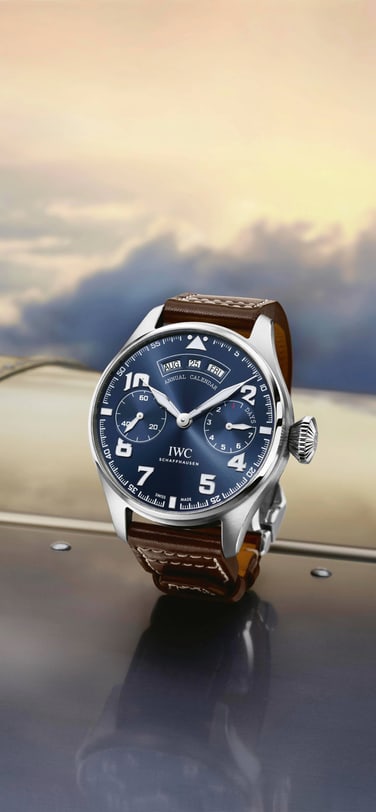
I’ve already picked my five Ingenieurs and five Portugieser wristwatches. For each group, I’ve spent only about 100,000 US Dollars or Swiss Francs. This time, I thought picking five great IWC Pilot’s Watches would be easy. But it became a perplexing task: too many watches and too little time!
IWC of course didn’t invent aviator watches as a horological category, but it certainly popularized them. In many respects, these watches represent the very principles underlying IWC: good, solid, practical engineering; a true tool watch, with timekeeping serving a special purpose.
Twenty-five years ago, when I first noticed IWC’s Pilot’s watches, it was love at first sight. Here was a precious watch –a fine movement—in a practical case with a practical dial. I was enamored with the anti-preciousness of the dial: clear, legible, and with a flat black base with bright Arabic numerals. Mechanical watches have a heritage and pilot’s watches have a special place within that tradition.
When one looks at IWC’s vintage Pilot’s Watches, there are perhaps four that stand out:
- The Mark IX –which is an aviator watch but its popular name is a misnomer: it really is the “Special Watch for Aviators” and not a military watch.
- The B-Uhr (navigation watch), now called the original Big Pilot’s Watch.
- The Mark X or W.W.W. –a great watch but not a true pilot’s watch: it was used by ground forces.
- The Mark 11 –IWC’s first megastar. A classic watch and perfect in every respect.

To start my collection here I first ruled out a Mark 10–they’re not for pilots. I like the Special Watch for Aviators, but it’s difficult to find, costly, and it seems to me that a historical pilot’s watch should have a military pedigree.
I therefore first vote for the Mark 11. It’s far less expensive than an original B-Uhr, and its size makes it wearable. It is truly iconic, and often it can be found at a good, although not inexpensive, price.
The Mark 11 is a “time only” watch, and given that perhaps the second watch should be a chronograph. There are many great IWC pilot’s chronos from which to choose, but my suggestion is to first look first at the earlier ones, from the late 1980s to the mid-1990s. They are not quite considered as “vintage”, but they represent a turning point in IWC history and are classic watches.
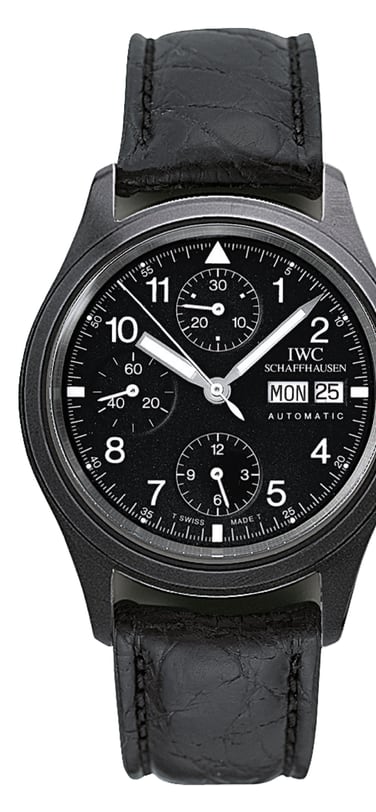
Chronographs have been used in flight since the advent of aviation. IWC never produced chronographs in its earlier years and as such never had a true “flieger chrono” until 1988. In that year, it introduced its mecaquartz pilot’s chronograph, reference IW3741. This model was the start of a renaissance of interest in pilot’s watches, not only for IWC but also the entire Swiss watch industry. A few years’ later, IWC then supplemented that with a “Doppelchrongraph”, reference IW3711, a clever rattrapante chronograph which could measure two elapsed times. This was followed in 1994 with a very popular pilot’s chronograph, reference IW3706. Finally, in 1995 on a limited production basis, IWC produced this chronograph with a ceramic case, as reference IW3705.
It seems abundantly clear that one of these pioneering pilot’s chronograph models should be added to this collection. The only problem is that they all have strengths calling for their inclusion. The mecaquartz model was the first, and is a relative bargain when found today. The Doppel is a special complication, which was developed in-house. The 3706 is an icon.
But to me the winner must be the ceramic model, IW3705. It’s distinctive, it’s relatively rare, but when found the price can be attractive. Above all, if a tool watch is intended to fly, metaphorically speaking, “under the radar”, the matte black case may be the epitome of that. Its discrete, functional and anti-precious appearance makes this watch special to me.
If one of IWC’s watches from 20 years ago has been added to the collection, certainly a more contemporary pilot’s watch also should also be added. If the choice for an “early” chronograph was difficult, choosing one from today’s repertoire, or at least recent history, becomes close to impossible. There are many very attractive candidates. Here, my subjective tastes come into play.
Fortunately, the search doesn’t need to look too far, although there is a cost premium. IWC has developed and produced a great in-house chronograph movement, calibre 89365 encased in reference IW3878. This model appears recently discontinued, perhaps in favor of the similar reference IW3777 with an ETA Vajoux base movement that might be more cost efficient. As before, IWC’s in-house chronograph movement might not tell elapsed time any “better” or prove more durable, but to me it is one of the best chronograph movements ever produced in Switzerland.
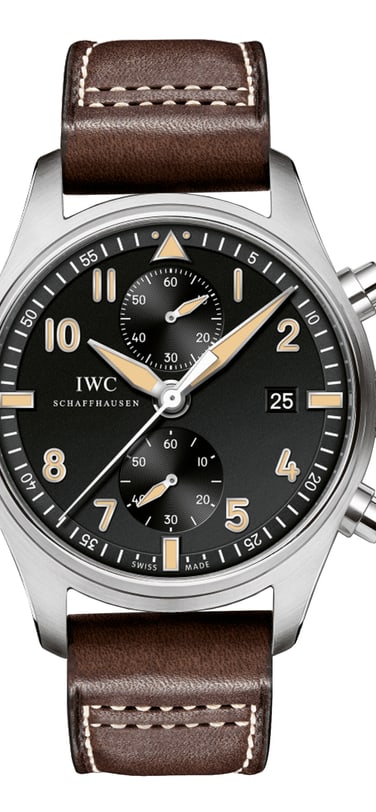
While the appearance of all reference IW3878 models is alluring, there are so many models that I can afford to be fussy. While I am intrigued by the mirrored look of the ardoise or slate dial of the basic IW3878 model, to my thinking it moves away from a tool watch concept. I then considered the gold version: after all no gold watch is a “true” tool watch, and perhaps an exception should be made since the watch is drop-dead beautiful. But on reconsideration, the triple date window takes the watch out of running for me. It’s again a subjective bias, but altimeters never really were part of the tradition of mechanical watches.
Then, another model caught my eye: reference IW3878-06, the Pilot’s Chronograph Antoine St. Exupéry. There’s a single date window at 6 o’clock. Being a retro-grouch, the stylized 1930s Arabic numerals smack of tradition, even if the watch’s design actually represents a fantasy. But to me this watch also has an Achilles’ heel: a “true” pilot’s watch should be antimagnetic, and this one isn’t. For most people and uses, it doesn’t matter, but as mentioned I personally believe in tradition.
I then not-so accidentally stumbled upon one chronograph that is perfect: reference IW3878-08. This watch, the Collectors Forum Pilot’s Chronograph or colloquially the “CF3”, is a now sold-out limited edition of 250 examples. And what a watch it is. Fine in-house movement, check. Flat black dial, check. Single date window, check. Anti-magnetic, check. True, I was more than a little behind the development of this version, but to me it is one of the best watches of its genre ever produced, not just by IWC but within the Swiss watch industry.
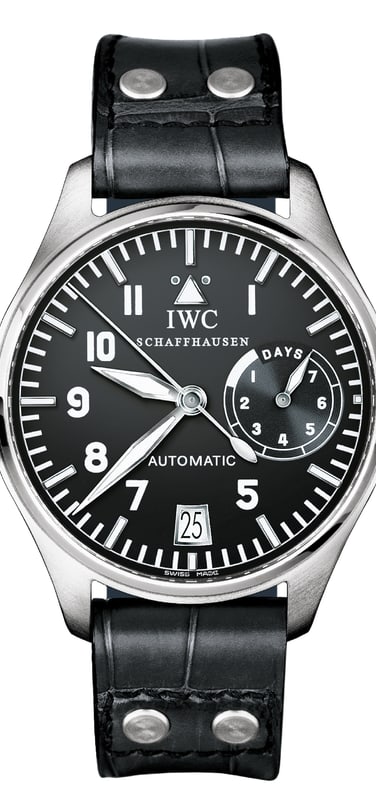
Even with this addition, there still are two more pilot’s watches to be added to this hypothetical collection. The next one, though, is somewhat easier to choose: it has to be a Big Pilot’s Watch. This watch has been an icon of IWC, and for good reason. The original IWC navigator’s watch from 1940 had become an important collectible, but at 55 mm in diameter it wasn’t practical for wearing, even though I did wear mine on the outside of a thick flight jacket.
The reference IW5002, the first watch called the “Big Pilot’s Watch” or “Grosse Fliegeruhr”, was intentionally large at 46.2 mm but still wearable. It deviated from the original by having a modern IWC in-house automatic movement, sporting a power reserve of 8 days. The dial had the added sub-dial of a power reserve indicator, stopping at 7 days to avoid isochronism error, plus a date window. This model, introduced in 2002, was a central seconds variant of IWC’s new movement, the caliber 5000 which debuted with great fanfare in 2000, and which here was known as caliber 5011.
Back in 2002, no one knew whether a 46 mm gargantuan watch would sell. But it quickly became a resounding success and a watch that was emblematic of IWC. It was bold and connoted adventure. It had an historical pedigree. It struck a genuine chord with collectors, including those who “graduated” up to IWC’s model from other increasingly popular 44 mm watches of other companies but without an in-house movement, let alone one as thoroughly modern as the caliber 5011 and later its subsequent iterations.
It didn’t then require any hesitancy to choose a Big Pilot’s Watch as one of the five. It belongs in every great IWC collection. But the problem, again, is which one to choose. This model has become so popular over 15 years that there is an embarrassment of riches. There have been numerous variations, some involving cases or complications, but especially dials. You can find this watch with red numerals or orange ones or blue. You can find it with a white dial or a silver dial, and you can find some with small rather than central seconds.
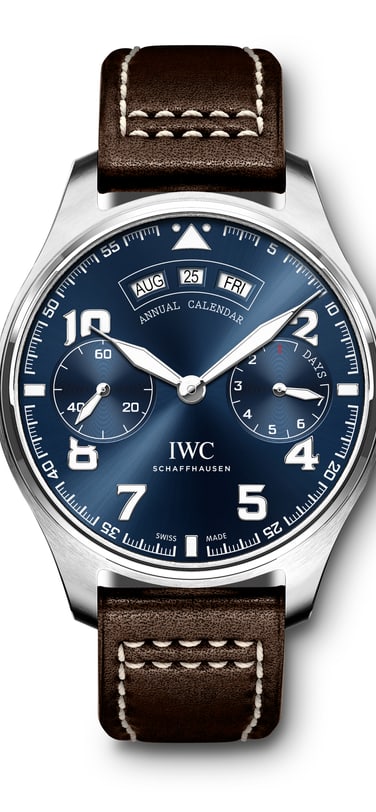
Since this hypothetical collection shouldn’t be only Big Pilot’s Watches, picking just one again is difficult. The purist in me begins thinking the first one –reference IW5002—makes sense as the seminal reference. Others prefer a 5002 with a “higher beat” movement, sometimes called a “transitional model” since a few of those were produced before the watch was redesigned. Still others prefer the redesigned references IW5004 and IW5008. The dial of those was changed to make the watch bolder, omitting the numeral 9 and redoing subtly other details. Most of the limited editions and various colors reflect that dial design.
There are dozens upon dozens of choices. Today, there new models in the reference IW5009 category with the 9 back on the dial. They include, in addition to regular steel and rose gold models, a ceramic “Top Gun” version, a beautiful Le Petit Prince variation with an alluring blue dial, and an oversized Heritage 48 example with small seconds.
Having pondered this issue endlessly, I have cast my lot for an “outlier” of sorts. IWC is producing a 100-piece limited edition titanium model in 2018, but with a dial and hands just like the original 5002. To my thinking, this model, a special version of a new reference IW5010, is the best of all worlds. It is totally traditional, totally IWC –especially given that IWC was a pioneer in titanium fabrication, but now totally modern. The only catch is that this model sold out before it made it to any stores.
With this new model Big Pilot’s Watch, my “flieger” collection has grown to four pilot’s watches:
- a Mark 11
- a reference IW3705 ceramic pilot’s chronograph
- a Collector’s Forum pilot’s chronograph (CF3)
- a Big Pilot’s Watch, special edition in titanium
In many respects, these four watches make almost a complete collection by themselves. Even better, of my hypothetical 100,000 USD, I calculate that I’ve spent less than 45,000. That to me is an excellent buy. All these watches are very special, most have been limited in production and three of the four have in-house movements.
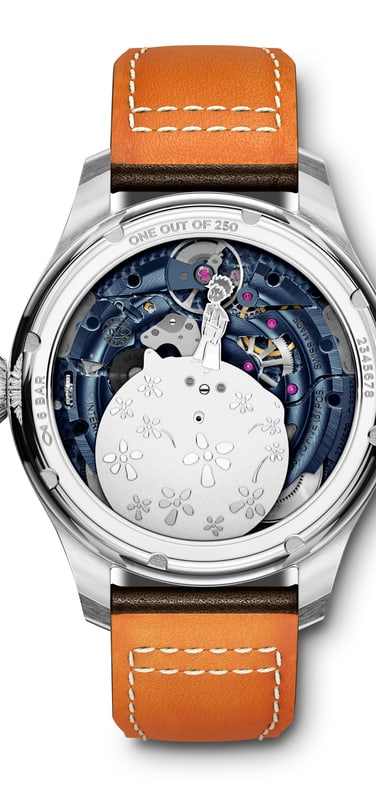
The fifth one then is the toughest to choose, even if my “war chest” now allows the purchase of a platinum or gold model, or one with special complications. Candidates include the gorgeous annual calendar “Le Petit Prince” Big Pilot, the perpetual calendar Big Pilot’s Watch “Antoine de Saint Exupery” or perhaps revisiting some of the earlier ones that were passed over. The 1936 Special Watch for Aviators perhaps should be reconsidered, or perhaps a platinum UTC model especially since the UTC module was designed by Kurt Klaus. My problem is that I like –no, love—them all. I lean towards the perpetual calendar but the new annual calendar is wonderful too. I simply cannot decide.
On the fifth one I will let the dear readers of this article decide. But until then I will tell you what I’m doing –I will hold out until IWC produces a tourbillon pilot’s watch.